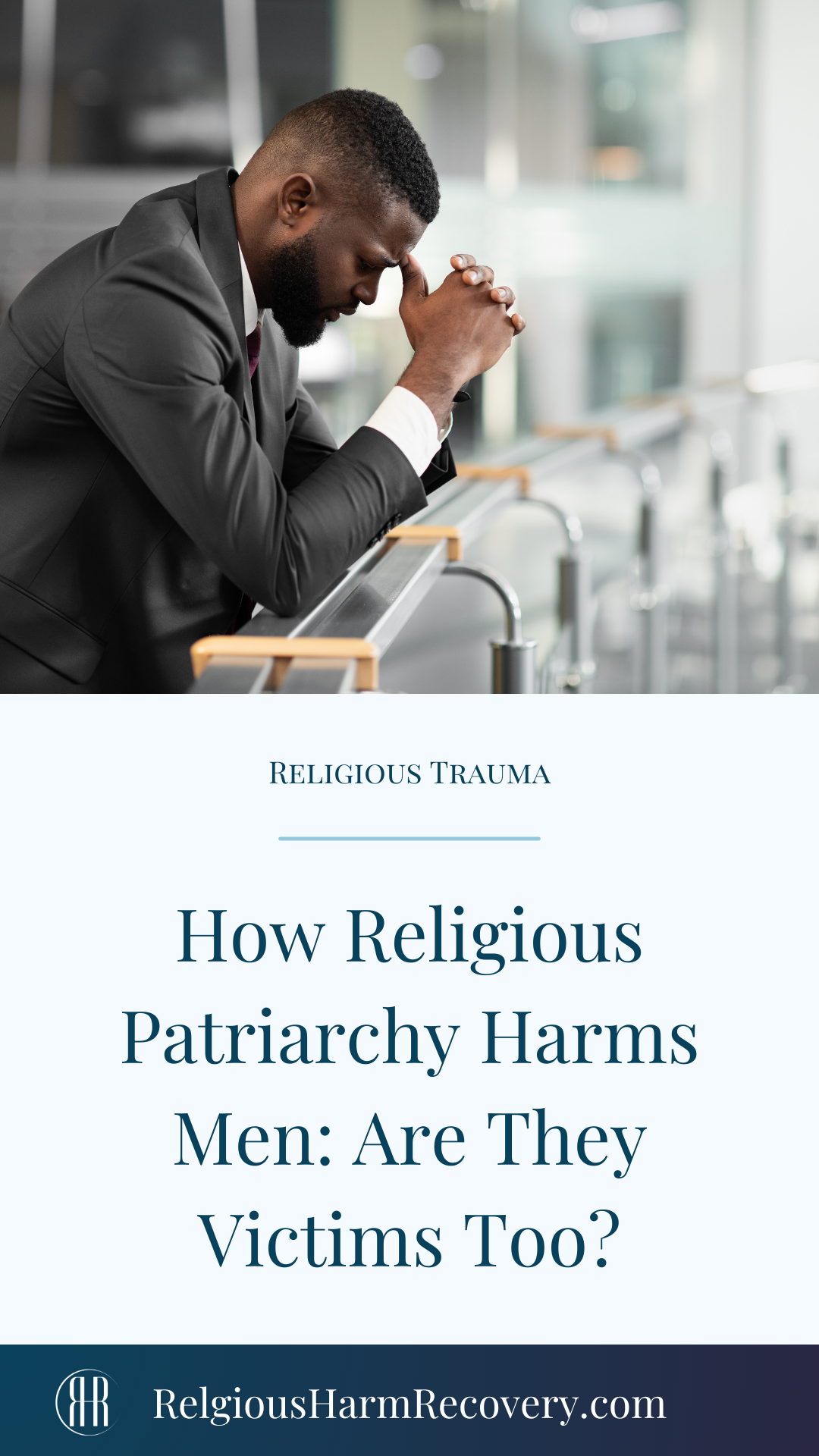How Religious Patriarchy Affects Men: Are They Victims Too?

When we discuss religious patriarchy, the conversation often centers around its impact on women and gender minorities.
However, it’s extremely important to recognize that patriarchal structures within high control religions can be very harmful to men as well.
In this article, I’ll guide you through an often overlooked aspect of religious trauma: the impact of religious patriarchy on men.
And we’ll also consider how, by working together (all of us), we can foster collective healing from its harmful effects.
What We’ll Be Covering:
The Paradox of Power in Religious Patriarchy
At first glance, it might seem that men reap only rewards from religious patriarchal systems.
After all, these structures often place men in positions of authority and leadership.
However, this power often comes at a significant cost to their emotional and relational well-being.
A male member of my Religious Harm Recovery Group on Facebook recently shared a poignant perspective:
“Being a church-going man sucked because even though on one hand they tell you you’re a leader, have authority, etc. on the other you’re told that you’re a broken sinner, can’t do anything without God, and that all of your natural desires are a sin.”
This perspective reveals a painful paradox…
While men are told they’re leaders, they’re simultaneously conditioned to believe they’re broken and powerless without god.
They’re expected to hold authority in the realm of morality, yet are told their natural desires are sinful.
They’re positioned as the providers in their households but end up in a loop of constant striving because “all blessings come from god,” rather than through their own efforts.
These contradictions can lead to a deep sense of inadequacy and confusion about one’s role and worth.
They also create intense cognitive dissonance that may result in chronic stress, mental health problems, and relational trauma.
The Psychological Toll of Religious Patriarchy on Men
Religious patriarchy can have significant negative effects on men’s psychological and emotional well-being.
Here are some specific ways these structures can harm men:
Additionally, men from marginalized communities may face unique challenges due to both patriarchal structures and other forms of oppression, further compounding these issues.
For instance, men of color may face additional pressures to conform to both religious and cultural expectations of masculinity.
LGBTQ+ men in patriarchal religious environments often experience heightened levels of shame and conflict between their identity and religious teachings.
Additionally, men with disabilities might struggle with feelings of inadequacy due to ableist interpretations of religious texts that equate physical prowess with spiritual worth.
The Systemic Nature of Religious Patriarchy
It’s important to understand that the harm caused by patriarchal religious structures isn’t just about individual actions or “toxic masculinity.”
It operates at a societal level, influencing behaviors and expectations across cultures and reinforcing rigid gender roles and power dynamics.
Feminist thinker bell hooks emphasizes that patriarchy harms everyone by enforcing a dehumanizing system that restricts both men and women.
While patriarchal structures have clearly oppressed women and gender minorities, they also place significant emotional and psychological burdens on men.
As we recognize the collective harm patriarchy causes, it becomes clear that our approach to healing must also be collective.
Escaping these structures requires more than personal introspection.
It calls for a community-wide effort to redefine masculinity, challenge harmful norms, and support each other in our healing journeys.
The Connection Between Religious Patriarchy & Religious Trauma
Religious trauma is a complex issue that can affect people across the gender spectrum.
It often originates from experiences in high control religions, which can include various forms of emotional, psychological, and sometimes physical abuse.
For men raised in these settings, the trauma can manifest in unique ways due to the expectations and roles placed upon them by patriarchal religious structures.
Men who have experienced religious trauma may exhibit several signs, including:
These often develop as a result of the rigid expectations and suppression of natural emotions that are common in patriarchal religious settings.
How to Begin Healing From Religious Patriarchy
Healing from religious trauma, particularly the trauma tied to religious patriarchy, is a deeply personal journey.
However, there are several concrete steps men can take to support their recovery.
And by taking these steps collectively, we can begin to dismantle the harmful systems that affect us all.
1. Acknowledge the Trauma:
The first step is recognizing that the pressures and expectations placed on you by patriarchal religious structures were harmful.
This isn’t about blaming yourself.
It’s about understanding the larger system at play and how it has affected your life.
2. Redefine Masculinity:
Challenge the harmful notions of masculinity ingrained by religious patriarchy.
This redefinition can be a powerful step toward healing and involves exploring positive, non-patriarchal expressions of masculinity.
3. Participate in Therapy or Support Groups:
Religious trauma is complex, and seeking help from a therapist who understands these dynamics can provide a safe space for healing.
Support groups with others who have experienced religious trauma can also offer valuable camaraderie.
My Membership Community is a great place to connect more deeply and intentionally with others who are also on this journey.
4. Explore and Express Emotions:
Learning to identify and express emotions in healthy ways is an essential part of the healing process.
Start by allowing yourself to feel without judgment, and practice sharing your emotions with trusted people.
5. Practice Self-Compassion:
Healing is a process that requires patience and kindness toward yourself.
Recognize that it’s okay to have setbacks and that recovery isn’t linear.
6. Take Collective Action:
Healing from religious patriarchy doesn’t happen in isolation.
By joining or fostering communities that value gender equality and inclusivity, you contribute to breaking the larger cycle of harm.
This collective action creates spaces where all people can heal from religious trauma together.
Collective Healing
Religious patriarchy impacts not only individuals but entire communities.
And it influences our understanding of gender, power, and worth.
Healing from this harm is both an individual and collective journey.
By broadening our understanding of how religious patriarchy affects men, we create space for more inclusive and compassionate healing approaches.
As we challenge harmful religious ideologies, it’s essential that we cultivate spaces where everyone feels seen, supported, and valued in their unique struggles with religious trauma.
Collective healing strengthens our communities by ensuring that no one’s experience is overlooked.
It invites us all, men, women, and gender minorities, to participate in a shared journey of recovery and growth.
Together, we can break the cycle.
Some Possible Next Steps:
If this article resonated with you and you’re looking to go deeper, here are a few things that may help.
Other Articles About Religious Trauma:
-
How Religious Trauma Affects Your Nervous System
This article explains how the nervous system responds to religious trauma—fight, flight, freeze, and fawn—why freeze and fawn are often the most common. It also includes how these trauma responses may still be showing up today.
-
How to Tell if You Have High-Functioning Religious Trauma
On the surface, high-functioning religious trauma looks makes it appear as though you “have it all together” while under the surface, this high-functioning persona is being fueled by fear, anxiety, and stress.
-
Religious Trauma Bonds: What They Are & How They Develop
In this article, I’m talking about something I see all the time in my religious harm recovery work: trauma bonds. While this term is often used when discussing abusive relationships, trauma bonds can also form in authoritarian religious groups where…


